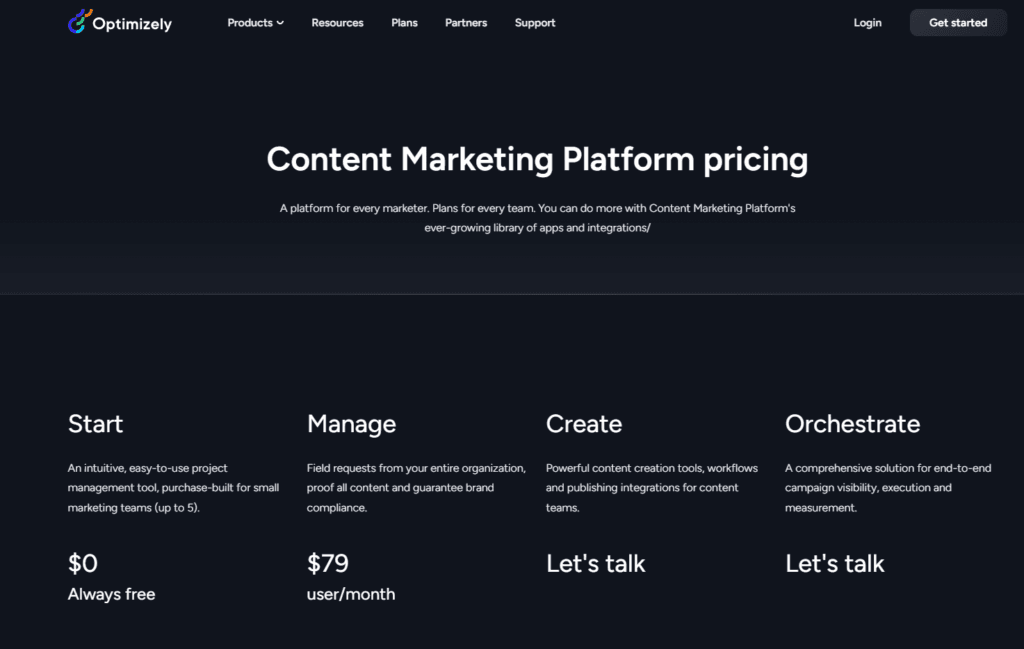In the vast ocean of data that modern businesses sail daily, choosing the right analytics tool is akin to selecting the best compass for your journey. On one side, there’s Zoho Analytics, with its broad horizon of data integration and comprehensive analysis capabilities, promising to guide businesses through complex data landscapes. On the other, Optimizely offers a more focused lens, primarily honing in on experimentation and optimization to enhance user experiences. But which tool will chart the course to insights that truly transform your business? Whether you’re navigating through the complexities of enterprise-wide data or steering towards optimized digital experiences, this guide embarks on a quest to reveal “The Best Analytics Tool for You.”
| Zoho Analytics | Optimizely |
|---|---|
 |  |
| G2 Score -4.3 out of 5 | G2 Score -4.3 out of 5 |
| TrustRadius Score -8.1 out of 10 | TrustRadius Score -8.6 out of 10 |
Area of Comparison: Experimentation and A/B Testing Capabilities
In a world where data-driven decision-making dictates the rise and fall of digital empires, the ability to experiment and test hypotheses is invaluable. Here’s how Zoho Analytics and Optimizely stack up when it comes to empowering businesses with experimentation and A/B testing capabilities.
Zoho Analytics: The Data Integration Maestro
Zoho Analytics, known for its comprehensive data analytics platform, focuses on providing businesses with deep insights across various functions and departments. While it excels in aggregating data from disparate sources and offering advanced analytics capabilities, Zoho Analytics is not inherently designed with a focus on experimentation and A/B testing. Its strength lies in delivering insightful reports and dashboards that help businesses make informed decisions based on historical data and trends.
For organizations looking for built-in experimentation and A/B testing capabilities, Zoho Analytics may require integration with third-party tools that specialize in these areas. However, its robust API and wide range of integrations mean that businesses can still leverage Zoho Analytics as part of a larger ecosystem that includes experimentation platforms.
Optimizely: The Experimentation Pioneer
Optimizely, on the other hand, positions itself as a leader in the realm of digital experience optimization, with experimentation and A/B testing at its core. It provides businesses with the tools to systematically test different versions of their digital properties, from websites to mobile apps, allowing them to understand what works best for their audience. Optimizely’s platform is designed to make it easy for teams to implement, track, and analyze experiments, driving continuous improvement in user experience and conversion rates.
With its user-friendly interface and powerful statistical analysis, Optimizely enables marketers, product managers, and developers to collaborate on optimizing digital experiences. The platform’s focus on experimentation empowers businesses to adopt a culture of testing, learning, and iterating, ensuring that decisions are always backed by data.
Pricing: Zoho Analytics vs Optimizely
Given the rich details we’ve explored so far about Zoho Analytics and Optimizely, let’s venture into an equally critical aspect of any technological adoption: Pricing. The cost of implementing an analytics platform can play a significant role in decision-making processes, especially when balancing the platform’s features against its total cost of ownership. Let’s examine how the pricing models of Zoho Analytics and Optimizely align with their offerings.
Zoho Analytics: Transparent and Scalable Pricing

Zoho Analytics is celebrated for its transparent and scalable pricing model, designed to accommodate the budgetary considerations of small to large businesses alike. The platform offers a free plan with basic capabilities, which is a great starting point for small teams or individuals just beginning their analytics journey. From there, the pricing tiers escalate based on features, data capacity, and the number of users, with each tier offering more advanced analytical capabilities.
This tiered approach allows businesses to scale their use of Zoho Analytics as their data analysis needs grow, without encountering prohibitive costs. Moreover, Zoho’s commitment to providing value is evident in its clear breakdown of features across different price points, ensuring businesses can choose the most cost-effective plan for their needs.
Optimizely: Custom Pricing for Targeted Solutions

Optimizely takes a different approach to pricing, focusing on custom solutions tailored to the specific needs of each business. Given its specialization in experimentation and optimization, Optimizely’s pricing is not publicly listed and varies based on the scale of usage, including the number of experiments run and the volume of user interactions analyzed.
This custom pricing model reflects Optimizely’s emphasis on providing tailored solutions that precisely fit the requirements of businesses focused on optimizing their digital experiences. While this approach can offer value by aligning costs directly with use and impact, it may require businesses to engage in detailed discussions with Optimizely’s sales team to understand the potential investment and ROI.
User Interface and Accessibility
Continuing our exploration requires delving into another vital aspect that significantly influences the selection of an analytics tool: User Interface (UI) and Accessibility. This facet is crucial as it directly impacts how users interact with the tool, uncover insights, and ultimately, the ease and efficiency with which data-driven decisions can be made. Let’s compare how Zoho Analytics and Optimizely fare in providing users with accessible and intuitive platforms.
Zoho Analytics: The Intuitive Data Navigator
Zoho Analytics prides itself on offering an intuitive and user-friendly interface, designed to cater to both seasoned data analysts and business users alike. The platform’s layout is clean and straightforward, making navigation a breeze. Users can easily create complex reports and dashboards with a few clicks, thanks to the drag-and-drop functionality, and there’s no steep learning curve to overcome.
This accessibility is further enhanced by Zoho Analytics’ mobile app, ensuring that insights are readily available on the go, facilitating decision-making at any time, from anywhere. For businesses that require a tool capable of serving a diverse user base with varying levels of technical expertise, Zoho Analytics stands out as a versatile and accessible option.
Optimizely: The Experimentation and Optimization Specialist
Optimizely’s platform is tailored for experimentation and optimization, with a focus on A/B testing and enhancing digital experiences. Its interface is designed to simplify the complexity of setting up, running, and analyzing experiments. Users can manage their experiments efficiently, with clear paths to creating tests, implementing variations, and interpreting results through easy-to-understand analytics and reports.
While Optimizely’s UI is highly specialized, it remains accessible to marketing professionals, product managers, and developers who may not have deep statistical knowledge but need to collaborate on optimization efforts. The platform’s specialization ensures that those focused on improving digital experiences find a user-friendly environment that supports rapid testing and iteration.

Related: Check out our free SEO suite

Advanced Analytics and Machine Learning Capabilities
Diving deeper into our comparison, let’s explore Advanced Analytics and Machine Learning Capabilities. In an era where predictive insights can set you miles ahead of the competition, the ability of an analytics tool to not just report on past and present but also predict future trends is invaluable. Let’s see how Zoho Analytics and Optimizely equip businesses with the power to forecast and optimize for the future.
Zoho Analytics: The Predictive Insight Generator
Zoho Analytics doesn’t just stop at offering descriptive analytics; it goes further by incorporating advanced analytics and machine learning into its suite. With features like predictive analytics and what-if analysis, Zoho Analytics allows businesses to forecast future trends based on historical data. Users can leverage built-in AI and machine learning models to uncover patterns and predict outcomes, facilitating more informed decision-making.
Moreover, Zoho’s AI-powered assistant, Zia, provides natural language processing capabilities, enabling users to ask questions in plain English and receive insightful answers. This blend of advanced features makes Zoho Analytics a potent tool for businesses looking to harness predictive insights and drive strategic planning with data-backed foresight.
Optimizely: The Optimization and Experimentation Pro
Optimizely’s core strength lies in its ability to enable businesses to conduct sophisticated experiments and optimize digital experiences based on real-time user data. While its focus is more on immediate optimization rather than long-term predictive analytics, Optimizely employs advanced statistical methods to ensure the reliability of experiment results.
The platform provides detailed analytics on A/B testing outcomes, allowing users to understand user preferences and behaviors deeply. This immediate feedback loop supports rapid iteration and optimization efforts, ensuring digital products and marketing strategies are always aligned with user expectations and evolving trends.
Customization
Diving into the aspect of Customization, we recognize its critical role in tailoring an analytics solution to precisely fit a business’s unique requirements. Customization can dramatically enhance the utility, relevance, and user engagement of an analytics platform by allowing for personalized dashboards, reports, and even specific analytical capabilities. Here’s how Zoho Analytics and Optimizely compare in empowering users with customization options.
Customization in Zoho Analytics
Zoho Analytics stands out for its robust customization capabilities, designed to serve a wide spectrum of business intelligence needs across various sectors. Users can create highly customized dashboards and reports, selecting from a vast array of visualization options, to mirror the unique metrics and KPIs relevant to their operations.
It allows for the combination of data from multiple sources, enabling users to create cross-functional reports and obtain a 360-degree view of their business. For businesses looking to offer analytics services to their clients, Zoho Analytics provides white-label options that allow for branding customization, presenting the tool as their own.
The platform also offers embedded analytics capabilities, enabling the integration of analytical reports and dashboards directly into users’ applications or websites, providing seamless access to insights. These customization features make Zoho Analytics a highly adaptable tool, capable of molding to the specific reporting and analytical needs of a business, enhancing data interaction and decision-making processes.
Customization in Optimizely
Optimizely focuses its customization capabilities around experimentation and optimization, with features designed to enhance the agility and effectiveness of digital experience testing. Users can tailor experiments extensively, defining variables, audiences, and goals to align with specific hypotheses or business questions.
For those less technically inclined, Optimizely’s visual editor allows for the easy customization of web pages to create variations for A/B testing without needing to write code. Beyond testing, Optimizely enables the customization of web content for different user segments, offering personalized experiences based on user behavior or predefined characteristics.
While not a direct customization feature, Optimizely’s robust APIs and integrations allow businesses to connect the platform with other tools, enriching the data used for experiments and personalization. Optimizely’s customization strengths lie in its capacity to refine and tailor the user experience optimization process, providing businesses with the tools to experiment effectively and personalize digital interactions.
Conclusion
In wrapping up our exploration of Zoho Analytics and Optimizely, we’ve navigated through the pivotal areas that set these analytics platforms apart. From their foundational data integration capabilities to the nuances of user interface, accessibility, advanced analytics, pricing models, and customization features, it’s evident that each tool carves its niche, aiming to empower businesses with the insights and optimization strategies they need.
This comparison between Zoho Analytics and Optimizely is designed to illuminate the paths each platform offers to businesses navigating the complex waters of data analytics and digital experience optimization. As you stand at the crossroads, ready to select the tool that will best serve your journey, remember that the most effective choice is the one that aligns with your unique challenges, aspirations, and strategic vision.
READ NEXT:
- SugarCRM vs Vtiger: The Best CRM Tool for You
- 11 Marketing Analytics Tools to Elevate Your Data-Driven Strategies
- 29+ Digital Analytics Software to Skyrocket Your Digital ROI
- Content Marketing in Crisis Situations: Navigating Challenges with Sensitivity
- Delivra vs ReachMail: The Best Email Marketing Tool for You
- 15 Contract Drafting Essentials for Non-Lawyers: Recommended by Experts
- SAS Visual Analytics vs Optimizely: The Best Analytics Tool for You





















Comments are closed.